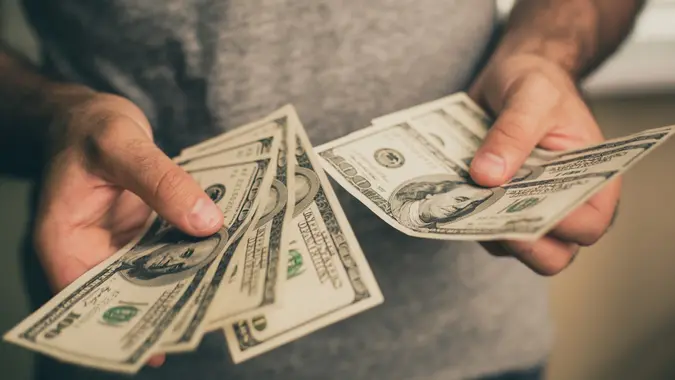I Rent Out a Home on Airbnb: Here’s How Much Profit I Actually Bring In

Commitment to Our Readers
GOBankingRates' editorial team is committed to bringing you unbiased reviews and information. We use data-driven methodologies to evaluate financial products and services - our reviews and ratings are not influenced by advertisers. You can read more about our editorial guidelines and our products and services review methodology.

20 Years
Helping You Live Richer

Reviewed
by Experts

Trusted by
Millions of Readers
Back in the day, going on vacation or visiting your family out of town usually resulted in having to find a hotel. In these modern times, Airbnb is a go-to choice for travelers looking to book accommodations for themselves and property owners who are looking to take advantage of some additional income.
The question of how much you can make varies from host to host in this short term rental game. According to Airbnb’s pricing strategies, most hosts pay a flat service fee of 3% of the booking subtotal, which is your nightly price plus any optional fees you charge guests, like a cleaning fee, but not including Airbnb fees and taxes.
So how much profit do you really make if you own an Airbnb? GOBankingRates asked a few hosts and found out.
Consider Both Profits and Costs
“As an Airbnb host, you can make good money, but you need to be aware of both the profit potential and hidden costs,” said Ben Julius, the founder of Tourist Italy.
“For example, the average U.S. Airbnb hosts earn around $13,800 per year, but this can vary depending on location and season,” Julius explained. “High-demand periods like holidays or peak tourist seasons can significantly boost your earnings. During these times, I’ve seen my nightly rates jump from $100 to $200, easily bringing in an extra $1,500 during a busy week.”
Hidden costs are a big factor. Julius highlighted the fact that hosts tend to face higher utility bills — about $50 extra per month — cleaning fees, which are around $75 per stay, local taxes and Airbnb’s host fee.
“Don’t forget about local regulations, as some areas might require a business license or additional taxes,” Julius added. “Plus, you’ll need to spend on maintenance and providing basic amenities for guests, which can add up to $100 monthly.”
“I also charge a refundable security deposit of $200 to cover any minor damages, which has been backed by Airbnb when needed,” Julius shared. “While Airbnb’s $1 million host guarantee and liability insurance provide some peace of mind, they don’t cover everything. I strongly recommend making sure your homeowner’s insurance policy covers your rental activities, and consider additional coverage if necessary.”
“In my experience, a well-located property in a popular area of New Jersey can generate about 20%-30% more income through Airbnb compared to traditional long-term rentals,” said Raf Pereira, the founder of Stocks.News.
“For instance, my two-bedroom apartment in Jersey City, which would typically rent for $2,500 monthly, brings in an average of $3,200 per month on Airbnb,” offered Pereira. “However, it’s crucial to factor in the hidden costs: cleaning fees– about $100 per turnover — higher utility bills — roughly 30% more — and increased wear and tear on furnishings.”
Pereira also pointed out that some often overlooked profit margin is the ability to block off dates for personal use, essentially giving owners free vacations, as well as the potential for long-term guests during off-peak seasons, which can help to stabilize income.
Demand Fluctuates
Shaun Bettman, part of Eden Emerald Mortgages in Sydney, Australia, commented that “… in a high-demand area like Sydney’s city center, a well-furnished one-bedroom apartment can generate anywhere from AUD $200 to $400 per night. However, actual profits depend on occupancy rates, which can fluctuate seasonally. On average, hosts might see a profit margin of 50%-60% after expenses, assuming an occupancy rate of 60%-70%.”
“There are several areas where Airbnb hosts can find unrealized profit margins, such as dynamic pricing strategies — adjust pricing based on demand — adding unique experiences [like] offering local tours or experiences, and optimizing tax deductions,” said Bettman.
Recalling from personal experience, Bettman shared, “One of my clients in Melbourne operates a two-bedroom Airbnb property that grossed approximately AUD $90,000 last year.”
After accounting for all expenses, including a mortgage, the net profit was around AUD $40,000.
“This represents a significant profit margin, particularly when considering additional revenue from upselling experiences and maximizing tax deductions,” Bettman explained.
Have Realistic Expectations
While you might be making additional income, much of which could be considered passive, some Airbnb hosts feel that the money is not exactly what was advertised when they put their additional room, in-law unit or home on the app.
“Airbnb hosting can be lucrative, but profit margins are often exaggerated,” said Chris Yang, co-founder of Coins Value, who also understood that the figures vary wildly depending on location, property type and market demand.
“In my case, I converted a spare bedroom in my San Francisco apartment into an Airbnb rental,” Yang explained. “Initially, I projected a monthly profit of $2,000. However, after accounting for all expenses, my monthly profit averaged $1,350. This 32.5% reduction in expected earnings was eye-opening.”
“Hidden costs significantly impact profitability,” added Yang. “Cleaning fees averaged $150 per turnover and consumed 15% of my gross income. Additionally, utilities increased by 30%, and I spent $200 monthly on amenities and supplies. These expenses and Airbnb’s 3% host fee reduced my profit margin to 55% of the gross income.”
Watch for Opportunities
But in the end, Yang admitted that unrealized profit opportunities also exist from being an Airbnb host — you just have to keep an open mind and seize opportunities when they arrive.
“By offering paid add-ons like airport transfers or local experience packages, I boosted my monthly income by an additional $300,” Yang said. “Furthermore, strategic pricing during peak seasons and events increased my occupancy rate by 20%, allowing for a 15% premium on nightly rates.”
What most hosts agreed on is that you have to understand the margins that come with your Airbnb. To keep profits up, understand your expenses, set competitive pricing, optimize your listing with high quality pictures and positive guest reviews, and take advantage of tax deductions from expenses related to your Airbnb rental — such as utilities, maintenance and insurance.
More From GOBankingRates
 Written by
Written by  Edited by
Edited by 

























